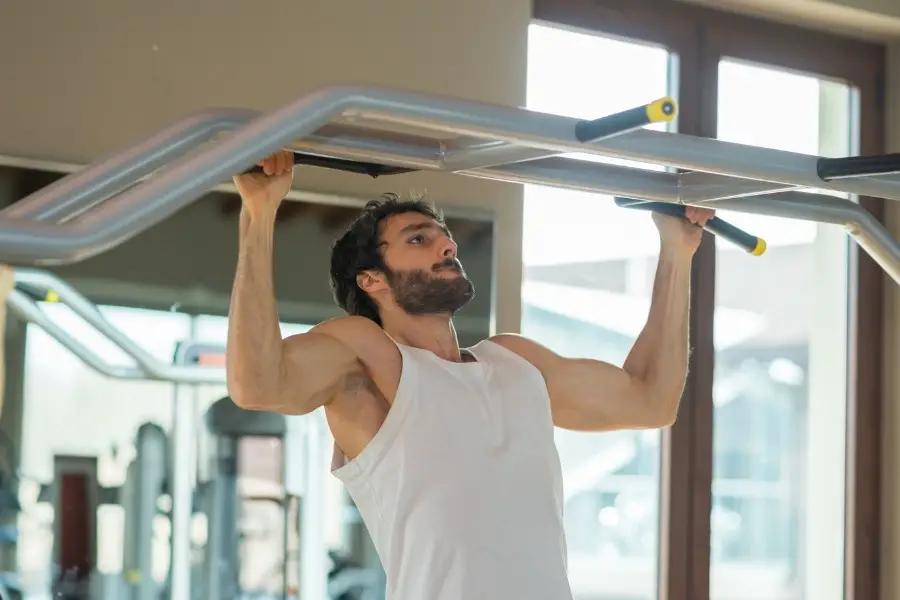
Cross training is an essential part of improving your climbing ability. I have a body building background and creating the best gym workout routine was one of my favorite things to plan out when I was first starting to get seriously into climbing. After testing out many different workout plans, I was able to create the best routine possible to improve climbing ability.
The best gym routine for improving your climbing ability is –
- Exercise 1: Pull-ups – 3 sets of 4 to 6
- Exercise 2: Squats – 3 sets of 4 to 6
- Exercise 3: Hammer Curls – 3 sets of 12 to 14
- Exercise 4: Dumbbell Wrist Rolls – 3 Sets of 12 to 14
- Exercise 5: Cardio – 30 minutes at moderate intensity
- Exercise 6: Planks – 3 sets of 1 minute duration
A proper warm up and stretching protocol are needed to prevent injuries when lifting weights. Training intensity and training frequency will vary depending on your current gym schedule and climbing routine. Getting enough rest is just as important if not more important than working your butt off in the gym.
If you are curious to see what the current prices are for the most popular rock climbing training aids, you can check them out on Amazon here (affiliate link).
The Best Gym Workout Routine For Rock Climbing
The best gym workout routine for rock climbing will target the most used muscles in climbing. Because climbing is a full-body workout, it is best to train in the same fashion. Hitting all of the major muscle groups in a single workout. This will keep your body accustomed to activating all of the muscles in a short time period.
Full-body workouts are more intense and draining than splitting workouts up across multiple days. For example, it is common in the body building world to train in the following splits:
- Bro Split. Bro splits focus mainly on training 1 muscle group per day.
- Push/Pull/Legs. This split organizes the exercises based on movement type. Pushing exercises on day 1, pulling exercises on day 2, leg exercises on day 3.
- Upper/Lower. This split organizes the exercises based on muscle location. Upper body exercises on day 1, lower body exercises on day 2.
- Full Body. Hits all of the major muscles groups in a single workout.
If you are climbing in conjunction with hitting the gym, I recommend sticking with the full body workout laid out above.
The Muscle Groups Worked When Climbing
The main muscles worked during rock climbing include the forearms, core, back, heart, legs, and biceps.
- Forearms. Your forearms are responsible for your grip strength. If you have weak forearms you will not be able to grab onto the small holds that climbing requires you to. Having strong forearms is crucial to keep yourself on the wall.
- Core. Your core is composed of your abs and obliques. These are responsible for stabilizing you, allowing you to twist, and do pretty much anything. Your core is involved in almost every single climbing movement.
- Back. The main muscle groups worked in your back are your traps and lats. These are responsible for pulling you up the wall. Basically, anytime you grab and pull something with your arms, these are getting worked.
- Heart. Climbing is a cardiovascular sport i.e. it works your heart and lungs. Have you ever felt out of breath when climbing? Boom. Cardio.
- Legs. The main muscles in your legs used when climbing are your glutes, quads, hamstrings, and calves. These muscles are responsible for pushing you up the wall.
- Biceps. These are used as an auxiliary to your back when you are doing pulling movements. Very few (if any) climbing moves rely solely on your biceps.

If you wish to learn more about what muscles get worked while climbing, you can check out my article linked here. That article goes into depth about what muscles groups are worked and how to properly cross train them. This article will lay out what makes the routine above the best gym workout for climbing and how to alter it if needed.
The Best Exercises For Training The Muscles Used Climbing
The most beneficial exercises will be compound exercises that recruit multiple muscles groups at the same time. Compound exercises are very tiring and will tax your body when performing them. Due to this, the workout only includes the three most important compound exercises for climbing : pull-ups, squats, and planks.
The remaining exercises are either isolation exercises or cardio. Isolation exercises are less taxing on the body and target specific muscle groups. Cardio will help you with your longer training sessions and will keep you climbing for longer. Targeting the forearms with isolation exercises will be the best as it will allow you develop a great mind muscle connection with them both while lifting and later on the wall.
The table below details the exercises included in the workout routine and what muscles they train.
| Exercise | Exercise Type | Major Muscles Trained |
| Pull-ups | Compound | Lats, traps, biceps, forearms, and core. |
| Squats | Compound | Quads, glutes, hamstrings, calves, and core. |
| Hammer Curls | Isolation | Biceps and forearms. |
| Wrist Curls | Isolation | Forearms |
| Cardio | Cardio | Heart, core, and legs. |
| Planks | Compound | Abs, obliques, quads, lats and deltoids (shoulders). |
As you can see in the table above, every major muscle used in climbing is worked in this routine. Performing this routine with the proper reps, effort, and consistency will dramatically increase your climbing ability.
The Optimal Reps For Training Climbing In The Gym
In the weight lifting world, it is widely accepted the the amount of reps performed in a set will have a direct impact on the benefits received. These rep schemes are as follows:
| Reps per Set | Training Benefit |
| 4 to 6 | Strength |
| 8 to 12 | Hypertrophy (muscle growth) |
| 12 and up | Endurance |
In practice these rep schemes are not so cut and dry. If you perform 14 reps of an exercise in each set, not only will your muscular endurance increase but so will your strength and size of your muscles. If you only perform 6 reps in each set, not only will your strength increase but so will your muscle size and muscular endurance.
The above table simply serves as a guide to maximize the training benefit received in relation to the others i.e. you will receive MORE of a strength benefit when performing 4 to 6 reps per set than if your perform 12 to 14 reps per set.
Picking The Right Rep Scheme For Climbing
It is important in climbing to maximize how strong you are (obviously) but also how long you are able to perform at a high level. That is why you should aim to increase your strength in the compound exercises (pull-ups, squats and planks). Getting stronger in these will allow you generate more power when climbing and will help you perform moves that you could only dream of before.

In my opinion, increasing your muscular endurance in your forearms is more critical than increasing overall strength. This is because you are constantly grabbing holds over, and over, and over again when climbing. Overall strength will help you grab harder holds but increasing your endurance will prevent you from getting pumped early and will let you climb for longer.
The longer you are able to climb, the stronger you will become in every other aspect of climbing. This will help you improve your technique and footwork as well as improve your cardiovascular endurance.
Optimal Intensity For Training Climbing In The Gym
Picking the perfect exercises and rep schemes doesn’t matter if you don’t actually put in the effort. If you are lifting weights for 4 to 6 reps but could lift them for 20+ reps and not be tired, you are doing it wrong. You will not be maximizing the potential benefits of lifting weights.
How To Determine Your Optimal Training Intensity
The best way to determine how heavy to lift is to go out and pick up a weight and perform the exercise to failure or close to failure. Failure is when your muscles are not able to complete the rep with proper form. If you have to “cheat” or change your form to complete the rep, then you have reached failure for that exercise.
Once you have a general idea of when you will reach failure, you can plan your workout around that number of reps and weight.
For beginners in the gym, you will want to leave more reps in reserve before reaching failure when planning your workout. This is because your muscles are primed for getting stronger and you do not need to put in as much effort to improve as more advanced lifters. I recommend when picking weights that you stop approximately 3 reps before failure. Most likely you will have a short trial and error period to find the right weight and reps.
More experienced lifters will need to train harder than newbies to get the same benefits. I recommend stopping your set when you have approximately 1 to 2 reps left before failure. Training to failure may be needed if you are very experienced in the gym. Going to failure in every set is not ideal because it will take a longer time for your muscles to recover from the beating.
Adjust Your Training Intensity Overtime
Once you have found the correct weight to perform your training, you will want to increase your intensity overtime. Increasing the intensity over time is part of “progressive overload”. Progressive overload is necessary to keep improving and getting stronger. It can be done by either increasing the weight, volume (amount of reps and sets) or frequency of your workouts.
The easiest way to progressively overload your muscles and what I personally recommend when starting out is to increase the weight of your exercises. Once you have reached a plateau, you can start to increase the amount of sets or training frequency. We do not want to alter the rep schemes too much at the start because they were specifically picked to increase the strength of your compound movements and endurance of your forearms.
The Best Order To Perform Your Gym Exercises In
As you may have noticed, the exercises presented above have been presented in the same order: pull-ups, squats, hammer curls, wrist curls, cardio, planks. This is the order you should perform these exercises in. These were chosen in a specific order to maximize your workout intensity and the benefits you will receive from each exercise.
Warm Up and Stretch Before Lifting

Before getting into these however, I recommend performing a brief warm up and stretching. A brief run/walk will get your muscles warm and ready to perform work. Ideally you will break a light sweat during this time. Stretching out your muscles after your warm up will help prevent injuries when lifting weights and will increase your flexibility.
Perform Heavy Compound Exercises First
After warming up and stretching out, it is time to perform the heavy compound exercises (pull-ups and squats). These exercises recruit the largest number of muscles and require the most energy. Due to this, you will be able to lift the most weight when performing these exercises. Lifting more weight will help you progress and get stronger faster. Doing these at the start of your workout when you are fresh will maximize this benefit.
Perform Isolation Exercises In The Middle Of Your Workout
Because isolation exercises target specific muscle groups, these do not require as much energy as compound exercises. Therefore, it is better to perform these exercises after doing your compound exercises. Doing these before your compound exercises will pre-exhaust your muscles and decrease the amount of weight you are able to lift in the more important, compound, exercises.
Do Cardio And Core At The End Of The Workout
Performing cardio and core at the end of your workout is ideal because you will have exhausted your muscles. Performing cardio and core before lifting weights will make you more tired when lifting and will decrease the amount of weight you are able to lift. Lifting before performing cardio and core will decrease how well you perform in these areas but the effect won’t be as great.
Your core is an incredible muscle group. Because it is used in almost everything you do, you are able to absolutely beat the crap out of it everyday and it will recover. It is one fo the only muscle groups you can do this with.
How Often You Should Train For Climbing
To allow for proper rest you will want to leave 24 to 48 hours of recovery before working the same muscles again. Because this workout is designed to target your muscles used when climbing, your climbing frequency will have to be taken into account as well.
For newer climbers and lifters I recommend sticking to a 3-day per week full body program. Where if you climb hard twice per week you can lift once per week. Or if you lift twice per week, then you should climb hard once that week. This will allow for the proper rest and recovery time.
You can increase the frequency of your climbing sessions if you would like but make sure that you are taking those extra sessions a little easier and focusing on your technique and footwork. Climbing and training too often will not allow your muscles to recover and can lead to injuries.
More experienced climbers and lifters will recover quicker than newer climbers and lifters. Due to this, they are able to up the frequency to 4 times of hard sessions a week and still recover.
Customize The Gym Routine To Fit Your Needs
The gym routine outlined needs to be customized to fit your individual needs. If you are very strong already then 4 to 6 pull-ups may be a cake walk for you. If you are still working on improving your fitness, 1 pull-up may still seem like a long ways away.
In addition to your current fitness level, you may want to specialize in a specific type of climbing i.e. bouldering or wall climbing. While training for these will be very similar, there will be a few key changes that can tailor the routine to the climbing type’s needs.
How To Customize The Routine For Strength Levels
Altering the routine to your current strength level will be dependent on how much weight you are currently able to lift. You will want to keep the reps the same to maximize the training’s benefits.
If you are very strong already, you can attach weight to a belt around your waist or hold a dumbbell with your feet when performing pull-ups to increase the difficulty. In addition to this, you can increase the difficulty of planks by placing plates on your back.
If you are not quite that strong yet to perform the routine, you can use resistance bands to assist you in pull-ups. To do this, tie both ends of the resistance band to the bar and step on the middle of it. This will help you pull yourself up. The thicker the resistance band, the more assistance it will provide. If planks are difficult to hold for the full minute, you can break them up into smaller intervals i.e. 30 seconds.
How To Customize The Routine For Bouldering vs Wall Climbing
Bouldering relies more on short bursts of power while top rope and sport climbing rely more on muscular and cardiovascular endurance. The workout routine provided is designed to help improve overall climbing ability and is not specific to either type of climbing.

I recommend dropping the reps from 12-14 to 6-8 for the hammer curls and wrist curls if you want to focus on bouldering. This will help increase your grip strength out put. In addition to this, instead of doing 30 minutes of moderate cardio opt instead to do 10-15 minutes of interval training. Alternate between 1 minute of hard effort and 1 minute of easy effort. This will improve your power bursts needed when bouldering.
For sport climbing and top rope I recommend changing the reps from 4-6 to 12-14 for the compound exercises. This will help build the muscular endurance needed for climbing for long distances. On top of this, if timing allows, you can increase the cardio session from 30 minutes to 45-60 minutes at a slightly lower intensity. This will help improve your cardiovascular endurance.
The bottom line? Performing the above listed gym workout routine will help improve your climbing ability dramatically. Be sure to do the exercises in the proper order at the right intensity and frequency to maximize the benefits. Altering the workout routine to fit your personal needs is recommended.
